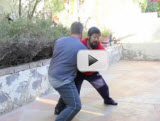The eight techniques of Taiji: peng, lu, ji, an, cai, lie, zhou and kao.
1. Peng: overall expanding energy.
2. Lu: energy that catches the opponent and make it come towards you.
3. Ji: energy that gets in close to the opponent but will not act on him.
4. An: energy that pushes but mainly separates from opponent.
5. Cai: energy that severs opponent by a pull or a jerk.
6. Lie (Lieh): energy that severs opponent by a even break (power on both ends or hands).
7. Zhou: energy that twists the opponent.
8. Kao: energy that is whole body action.



{ 6 comments… read them below or add one }
Based on the description in this list here, how does one differentiate Kao from Peng? Just trying to clarify that in my head. Thanks.
Hi James, my understanding of it is that Peng is the energy created from a stretch. So say you don’t move your back, for example, and extend your arms from that non moving point, you created some peng energy. Kao is that you lock the whole body as one piece, nothing moves and you issue power from the feet. You strike with the whole body mass as a solid structure and can use any body part as the impact point, but often, it is the hip, shoulder, or back that makes contact. Master Chen will say Kao is like you are moved as if someone else moved you, like someone pushed a statue into another person and you are hit by the whole statue. So the separation is between the ground and your body, I think. Whereas , typical Peng, the separation is created between body parts. Does that make sense?
Bruce, thank you for the explanation.
http://practicalmethod.com/2014/07/eight-techniques-of-taijiquan-online-video-trailer/
I actually don’t quite remember posting this. I think it might have been part of some workshop notes I sent to Shifu Chen.
Before I met Shifu Chen, I thought, like most other Tai Chi enthusiasts, that the Eight Methods is some kind of secret key, the knowledge of which would unlock INCREDIBLE TAI CHI POWERS. I suppose on some level they are but not in the way most Tai Chi practitioners think. If one masters Taijiquan, one will have mastery of the Eight Methods, however if one masters the Eight Methods, they will not necessarily have mastered Taijiquan. It took me any years to realize that the real key to mastery of taijiquan has never been knowledge. The key is practice. One must also have a knowledgeable guide, but knowledge alone is worse than useless.
Soon after I met Joseph, I don’t think I was a disciple yet, I flew to Edmonton to train for several days. I must have asked him about the Eight Methods, but perhaps not in those terms. In his basement while pushing hands, he showed me, this is peng. This is lu. This is ji and so on gong over each one so that I was familiar with it.
Later at dinner, we were talking about me writing some articles on Taijiquan. I suggested one on the Eight Methods or just peng, lu, ji, an, since I now understood them. Shifu Chen asked how I would describe what I now understood. I attempted describe what I had learned. Shifu said, “Richard, you are parroting the descriptions given by authors who parroted others who parroted the words of a few men who actually knew what the Eight Methods were. The problem is not the descriptions. The descriptions are remarkably correct, but one can’t get from the description to the method, only the other way around.”
He, then, challenged me to start thinking of and describing Taijiquan in new ways. A challenge that I accepted, but it took me a couple of years to realize that Shifu had already been teaching me to think of and describe Taijiquan in new ways.
Richard, thank you for the background and insights.